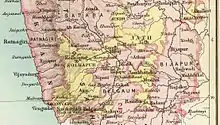Aundh State
Aundh State was a Maratha princely state in the British Raj, in the Deccan States Agency division of the Bombay Presidency.[1][2]
| Aundh State | |||||||||
|---|---|---|---|---|---|---|---|---|---|
| Princely State of British Raj | |||||||||
| 1699–1948 | |||||||||
 Flag | |||||||||
 Aundh State in the Imperial Gazetteer of India | |||||||||
| Area | |||||||||
• 1941 | 1,298 km2 (501 sq mi) | ||||||||
| Population | |||||||||
• 1941 | 88,762 | ||||||||
| History | |||||||||
• Established | 1699 | ||||||||
| 1948 | |||||||||
| |||||||||
| Today part of | Maharashtra, India | ||||||||
The Principality of Aundh covered an area of 1298 square kilometers with the population of 88,762 in 1941.[3]
History
Aundh was a Jagir granted by Chhatrapati Sambhaji to Parshuram Trimbak Pant Pratinidhi, who was a general, administrator and later Pratinidhi of the Maratha Empire during the reign of Chhatrapati Sambhaji and Chhatrapati Rajaram.[4] He played a crucial role in re-capturing Panhala Fort, Ajinkyatara (at Satara), Bhupalgad forts from Mughals during period of 1700–1705.[5]
After the fall of Peshwa rule, the British East India company entered separate treaties in 1820 with all the Jagirdars who were nominally subordinate to the Raja of Satara.[6] Aundh became a princely state when Satara state was abolished by the British under the Doctrine of lapse. The last ruler of the Aundh was Raja Shrimant Bhawanrao Shriniwasrao Pant Pratinidhi ("Bala Sahib"). The state joined the Union of India on 8 March 1948.[7][8]
Rulers
Aundh's Hindu rulers used the title of "Pant Pratinidhi".
| Foundation of the state Aundh | ||||
|---|---|---|---|---|
| Princes (Rajas), with the title Pant Pratinidhi[9] | ||||
| From | To | Raja | Born | Died |
| 1697 | 1718-05-27 | Parusharam Trimbak | 1660 | 1718 |
| 1718 | 1746-11-25 | Shrinivasrao Parashuram | 1687 | 1746 |
| 1746 | 1754 | Jagjivanrao Parashuram | 1691 | 1754 |
| 1754 | 1776-04-05 | Shrinivasrao Gangadhar | 1776 | |
| 1776 | 1777-08-30 | Bhagwant Rao | 1777 | |
| 1777-08-30 | 1848-06-11 | Parashuramrao Shrinivas "Thoto Pant" (Peshwa prisoner 1806-1818) | 1777 | 1848 |
| 1848-06-11 | 1901 | Shrinivasrao Parashuram "Anna Sahib" | 1833-11-27 | 1901 |
| 1901 | 1905 | Parashuramrao Shrinivas "Dada Sahib" | 1858-02-17 | 1905 |
| 1905-11-03 | 1909-11-04 | Gopalkrishnarao Parashuram "Nana Sahib" | 1879-01-26 | |
| 1909-11-04 | 1947-08-15 | Bhawanrao Shriniwasrao Pant Pratinidhi "Bala Sahib" | 1868-10-24 | 1951-04-13 |
| Prime-minister[9] | ||||
| From | To | Raja | Born | Died |
| 1944 | 1948 | Parshuram Rao Pant "Appa Sahib"[10] | 1912-09-11 | 1992-10-05 |
| The Line is nominally Continued | ||||
|---|---|---|---|---|
| From | To | Raja | Born | Died |
| 1951 | 1962 | Shrimant Bhagwant Rao Trimbak "Bapu Sahib"[11] | 1919 | 2007-04-08 |
See also
References
- I. Copland. State, Community and Neighbourhood in Princely North India, c. 1900-1950. Springer. p. 95. Retrieved 26 April 2005.
- Ian Copland. The Princes of India in the Endgame of Empire, 1917-1947. Cambridge University Press. p. 214. Retrieved 16 May 2002.
- Rothermund 1983, p. 9.
- Bond 2006, p. 773.
- Gurcharn Singh Sandhu (2003). A military history of medieval India. Vision Books. p. 648.
- Sumitra Kulkarni (1995). The Satara Raj, 1818-1848: A Study in History, Administration, and Culture. Mittal Publications. p. 18. ISBN 978-81-7099-581-4.
- "Aundh Princely State". Archived from the original on 8 August 2018. Retrieved 11 August 2017.
- Rothermund 1983, p. xvii.
- Princely States of India A-J
- "Aundh princely state rulers". Archived from the original on 8 August 2018. Retrieved 11 August 2017.
- Who's who in India, Burma & Ceylon. p. 75.
Heir apparent- -Shrimant Bhagwant- rao alias Bapusaheb (nominal)
Bibliography
- Rothermund, Indira (1983). The Aundh Experiment: A Gandhian Grass-roots Democracy. Somaiya Publications.
- Pant, Apa (1989). An Unusual Raja: Mahatma Gandhi and the Aundh Experiment. Sangam Books.
- Bond, J.W (2006). Indian States: A Biographical, Historical, and Administrative Survey. Asian Educational Services.
- Pant, Apa (1990). An Extended Family Or Fellow Pilgrims. Sangam Books.
